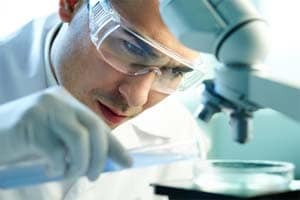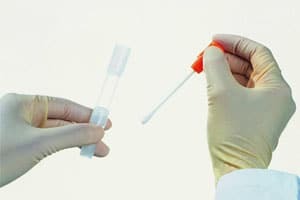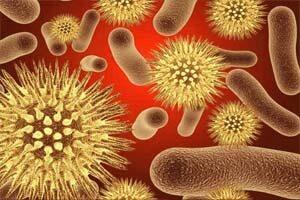Often for the diagnosis of any urological pathology in a man, it is necessary to take a test for the smear from the urethra. Many have already come across such a procedure, others do not even suspect how the PCR analysis is taken and why it is actually needed. But such a study has an important diagnostic value, because it informs the specialist about the state of the urino-genital organs and their functioning, about the presence of inflammatory processes or pathogenic microflora such as trichomonads, various cocci, etc.

The essence and purpose of the
procedure Modern diagnostic techniques are quite numerous, buteach has a certain scope of activity. Some methods are designed to diagnose cancer pathologies, others are used to detect any infections, etc. There is also a technique that has an increased sensitivity to specific molecular substances and pathogens - polymer chain reaction or PCR.
For this type of research, a man needs to obtain a biomaterial, which usually uses blood, a smear from the urethra, sperm or saliva. Most often, PCR is carried out with the study of a bacteriological smear from the urethra. Such a study helps to identify sexual infections like mycoplasmosis or trichomoniasis, chlamydia or ureaplasmosis, gonorrhea, as well as prostatitis, urethritis, etc.
 By carrying out a polymerase reaction, it is possible to detect the presence of viral hepatitis, mononucleosis, HIV infection or papillomavirus infection, tuberculosis, candidiasis,virus or tick-borne encephalitis, cytomegalovirus and Helicobacter infection. Polymerase chain reaction has many advantages. Such a diagnostic procedure has high indicators of the reliability of the study, takes a short period of time, is capable of simultaneously detecting several pathogenic microorganisms. The risk of obtaining erroneous results when carrying out PCR is minimal.
By carrying out a polymerase reaction, it is possible to detect the presence of viral hepatitis, mononucleosis, HIV infection or papillomavirus infection, tuberculosis, candidiasis,virus or tick-borne encephalitis, cytomegalovirus and Helicobacter infection. Polymerase chain reaction has many advantages. Such a diagnostic procedure has high indicators of the reliability of the study, takes a short period of time, is capable of simultaneously detecting several pathogenic microorganisms. The risk of obtaining erroneous results when carrying out PCR is minimal.
Preparing for the
study For high diagnostic reliability of the results, it is necessary to prepare for the PCR analysis in advance. For this, it is necessary to observe certain conditions:
- On the eve of the night( preferably before going to bed) it is necessary to carefully wash the genitals;
- Two days before sampling the biomaterial, you should stop having sex;
- When passing the course of antibiotic therapy, it is necessary to notify a specialist about this, which, most likely, will postpone the procedure of the study for a fortnight;
- It is necessary to empty the bladder several hours before sampling the biomaterial( approximately 2-3) and it is impossible to walk to the toilet. The next urination will be possible only after the study.
The fulfillment of such conditions is necessary for the reliability of the results, otherwise the information obtained will be highly distorted, which threatens with inadequate and ineffective treatment. Of particular importance is the reliability of the results in the development of various pathogenic microflora such as trichomonads, various kinds of cocci, gonorrhea, etc.
The course of the procedure
 Biomaterial is collected by a medical probe or a cotton swab that is inserted into the urethra by about a centimeter to 3. According to many patients,the procedure delivers unpleasant discomfort, and in some men it was accompanied by painful sensations. After taking a smear a few more hours can be troubling some discomfort in the penis. A man can feel some itchy soreness or burning sensation in the urethra, mainly in the head region, may be disturbed by cutting pains during urination.
Biomaterial is collected by a medical probe or a cotton swab that is inserted into the urethra by about a centimeter to 3. According to many patients,the procedure delivers unpleasant discomfort, and in some men it was accompanied by painful sensations. After taking a smear a few more hours can be troubling some discomfort in the penis. A man can feel some itchy soreness or burning sensation in the urethra, mainly in the head region, may be disturbed by cutting pains during urination.
Sometimes, for a more informative analysis of PCR, a preliminary urethral massage is required, which is performed by inserting a medical probe into the urethra. When examining prostatic pathologies before PCR diagnosis, there may be a need for a prostate massage, which is performed by inserting an index finger into the anal opening.
Usually, this procedure takes no more than 2 minutes. After taking the material for the polymerase chain reaction, additional components, such as magnesium ions, which perform the catalytic functions, DNA polymerase, the most important DNA-forming enzyme, primers, special medium and physical factors, are also needed. In fact, PCR is carried out in order to breed a pathogenic fragment, if found in the biomaterial under study. Therefore, by the end of the procedure of detected fragments, there are more than a thousand.
A buffer solution with a specific acidity and density, as well as a specific ionic composition, acts as a medium for the polymerase chain reaction. As for the physical factors, they include the necessary temperature parameters of the ambient air and solution, atmospheric humidity, etc. Under the influence of all the above conditions and components, a reaction occurs in which necessary DNA components are extracted from the smear. If they are present in the biomaterial, the reaction continues, but if such components are absent, the polymerase reaction is considered negative.
Areas of use of the
method The principle of such a study is the detection in the resulting biomaterial of a small DNA fragment of the causative agent of the alleged infectious disease. PCR diagnosis is unique in the absence of contraindications to the study. Usually such a diagnostic technique is used in the following situations:
- To identify STDs. A PCR study helps to identify virtually any sexual infection transmitted through sexual intercourse. The undoubted advantage of this reaction in this case is the fact that many causative agents of sexual infections can multiply asymptomatically for a long time in the genital tract. The use of PCR diagnostics makes it possible to identify such diseases at the very initial, asymptomatic stage, when treatment will be the easiest;
- With incorrect or negative data obtained from other diagnostic procedures. Many studies show an incomplete picture of the pathological process, and PCR can give a full range of pathological changes;
- For the purpose of specification of oncological processes. Unfortunately, it is often impossible to detect the presence of a cancer marker in cancer patients. In this situation, the polymerase reaction easily identifies abnormal cellular structures and oncomarkers, which increases the information content of tumor diagnosis;
- As an alternative replacement for more expensive diagnostic tests. Although the polymerase reaction is costly, but sometimes this diagnosis is more than enough to detect a disease, while more expensive studies can be less informative or completely useless;
-
 To identify residual elements after antibiotic therapy. It often happens that after the course of treatment with antibiotic drugs, microorganisms remain in the body, against which the struggle was going. Their number can be insignificant, why they are incapable of provoking the recurrence of the disease. But such a "reserve" can be activated with a decrease in immunity and other favorable factors, then a relapse can not be avoided. Identify such reserves will help PCR diagnostics.
To identify residual elements after antibiotic therapy. It often happens that after the course of treatment with antibiotic drugs, microorganisms remain in the body, against which the struggle was going. Their number can be insignificant, why they are incapable of provoking the recurrence of the disease. But such a "reserve" can be activated with a decrease in immunity and other favorable factors, then a relapse can not be avoided. Identify such reserves will help PCR diagnostics.
This diagnostic technique refers to universal methods of investigation, and its high sensitivity and high information make PCR irreplaceable.
Interpretation of results
Usually, the results are reported to patients as early as 24 hours, however, it is possible that the reaction produces the results of the study after an hour. Usually, this happens with negative results of PCR diagnostics. If the final results are positive, this indicates the presence of a specific pathogenic microorganism in the male genitourinary tract at the time of harvesting the biomaterial.
Sometimes it happens that, being a carrier of any serious infection, a man does not observe pathological symptoms, but can spread the disease, infecting her with his sexual partners. In such a situation, the polymerase reaction will help to detect the latent infection carrier, the degree of activity of the pathology, the stage of its development, and other parameters.
Carrying out PCR in real time mode is practically not capable of giving a false positive result, that is, indicating the presence of an infectious process, whereas there is none. This usually occurs when the infection is dormant and is not active at the time of the study.
PCR diagnostics today is considered an error-free and highly informative research method, however, one should not resort to it at every opportunity. After all, such diagnostics are very expensive. And for the detection of some infectious pathologies, it is sufficient to conduct and more accessible assays. Therefore, the need for this diagnosis should consult a doctor.



